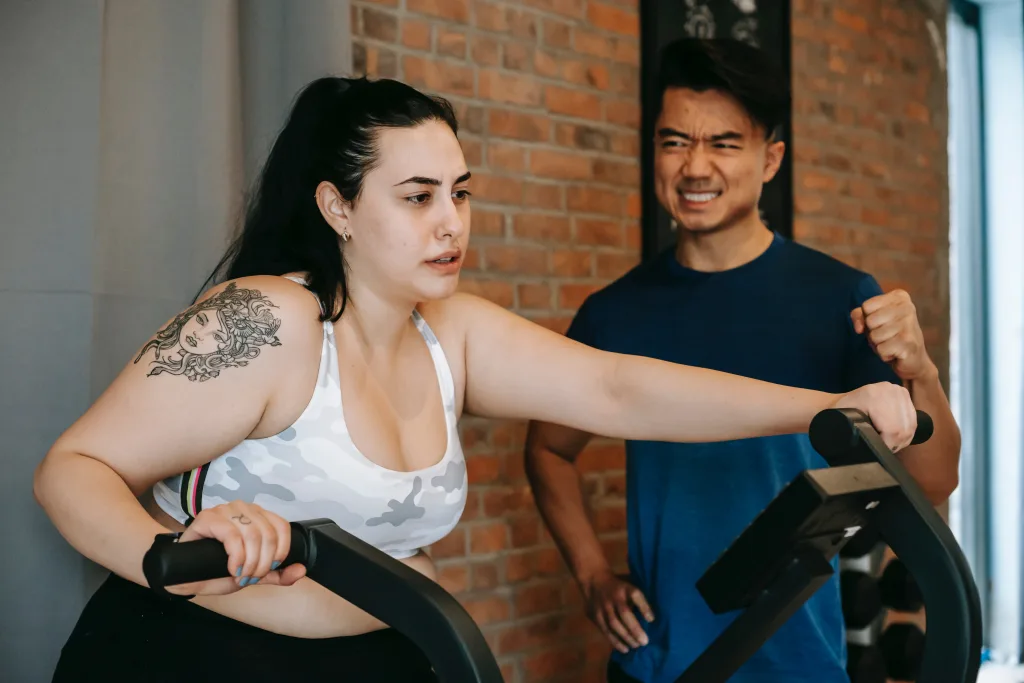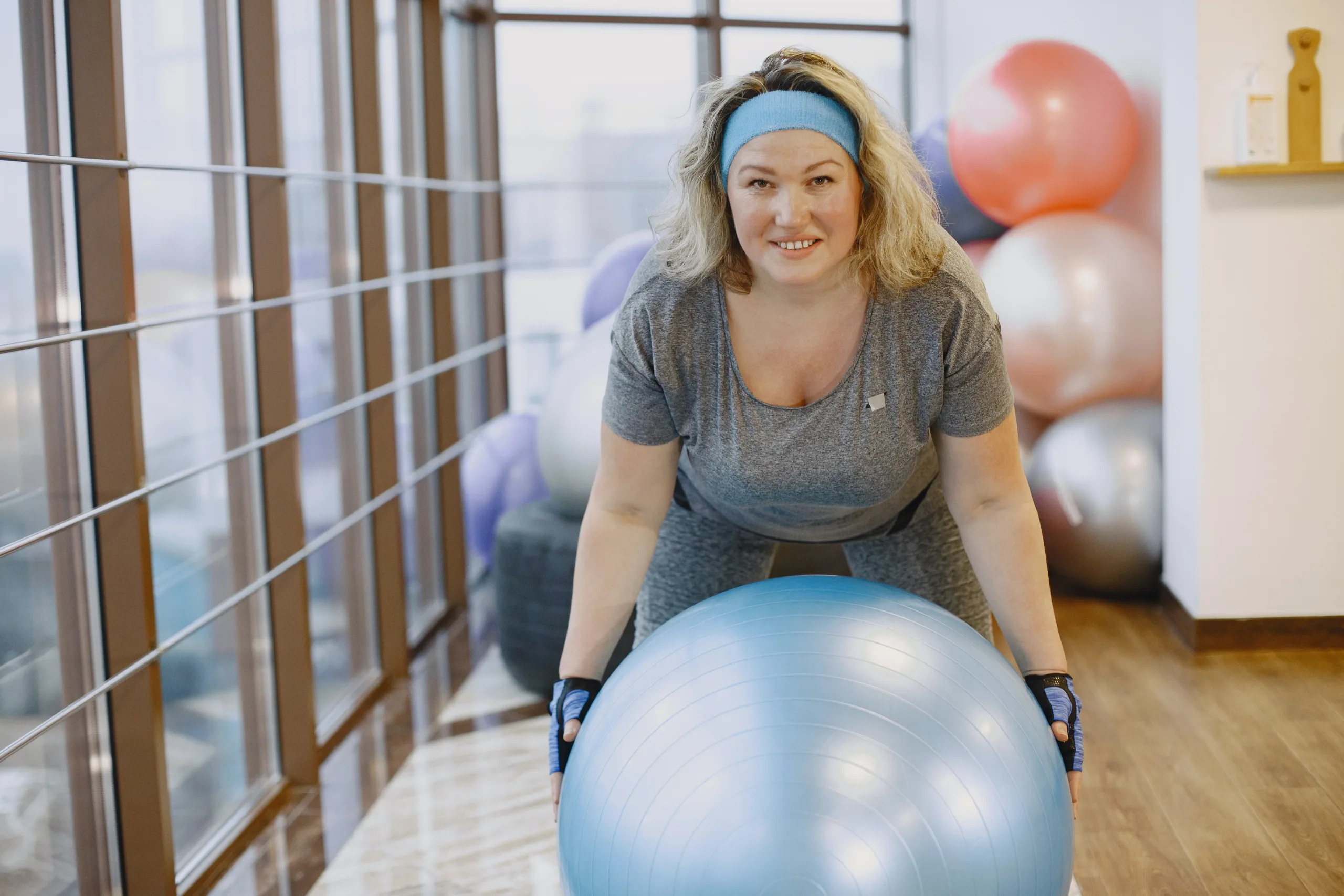Exercise is an essential aspect of maintaining overall health and well-being. For individuals with obesity, finding the right exercises to begin with can be crucial. Contrary to popular belief, the primary goal of exercise for obesity is not solely weight loss. Exercise offers significant physical and mental health benefits for everyone, regardless of their size. Bodyweight alone is not a reliable indicator of fitness level. It is important to remember that individuals with similar body mass indexes (BMIs) can have varying abilities. Therefore, it is crucial to start slowly and adapt movements to suit individual needs. In this blog post, we will explore beginner exercises specifically designed for obese individuals, taking into account their goals, preferences, and unique needs.
Benefits of Low-Impact Exercises for Obese Individuals
Exercise plays a crucial role in improving the overall health and well-being of individuals, regardless of their size or weight. For overweight individuals, low-impact exercises can be particularly beneficial owing to their reduced strain on joints and lower risk of injury. In this section, we will explore the benefits of low-impact exercises for overweight individuals.
Reduced Joint Stress and Injury Risk

Low-impact exercises such as walking, cycling, swimming, and using elliptical machines are gentle on the joints, making them ideal for individuals carrying excess weight. These exercises help minimize the stress placed on weight-bearing joints like the knees, hips, and ankles. By reducing joint stress, low-impact exercises help mitigate the risk of injuries that may arise from high-impact activities.
Enhanced Cardiovascular Health
Engaging in low-impact cardiovascular exercises helps improve heart health and strengthen the cardiovascular system. These exercises increase heart rate and promote blood circulation throughout the body, delivering oxygen and nutrients to various organs and muscles. Regular low-impact cardiovascular exercises, like brisk walking or swimming, can help lower blood pressure, improve cholesterol levels, and reduce the risk of heart disease.
Improved Muscular Strength and Endurance
Strength training exercises are an integral part of any fitness routine, even for overweight individuals. Low-impact strength training exercises, such as using resistance bands or performing bodyweight exercises, help build and tone muscles without placing excessive stress on the joints. These exercises not only increase muscular strength and endurance but also contribute to improved metabolism, aiding in weight management.
Increased Flexibility and Range of Motion

Low-impact exercises that focus on flexibility, such as yoga or stretching routines, can be highly beneficial for overweight individuals. These exercises improve flexibility, enhance joint mobility, and increase range of motion. By incorporating regular flexibility exercises into their routine, individuals can improve posture, reduce muscle tension, and alleviate discomfort caused by excess weight.
Boosted Mood and Mental Well-Being
Physical activity, including low-impact exercises, has been shown to have a positive impact on mental health. Engaging in regular exercise releases endorphins, also known as “feel-good” hormones, which can help alleviate stress, anxiety, and depression. For overweight individuals who may face challenges related to body image and self-esteem, low-impact exercises can be a source of empowerment, promoting a sense of accomplishment and improving overall mood.
Conclusion
Low-impact exercises provide numerous benefits for overweight individuals, ranging from reduced joint stress and injury risk to improved cardiovascular health, muscular strength, flexibility, and mental well-being. By incorporating these exercises into their fitness routine, overweight individuals can take significant steps towards enhancing their overall health and achieving their wellness goals. Remember to consult with a healthcare professional or a certified fitness trainer before starting any new exercise program.
Walking for Overweight Individuals
Walking is a highly recommended form of exercise for individuals with overweight and obesity. It is a simple and low-impact activity that offers numerous benefits for both physical and mental health.
Benefits of Walking for Overweight Individuals
Regular walking can have a tremendous effect on your body and brain. Here are some key benefits:
- Weight Loss: Walking is a great way to burn calories and promote weight loss. By engaging in regular walking sessions, you can create a calorie deficit and achieve your weight loss goals.
- Improved Cardiovascular Health: Walking is a cardiovascular exercise that strengthens your heart and improves blood circulation. It can help lower your risk of heart disease, high blood pressure, and stroke.
- Enhanced Muscle Strength and Tone: Walking engages various muscle groups, including your legs, glutes, and core. Over time, this can lead to improved muscle strength and tone.
- Boosted Mood and Mental Health: Walking releases endorphins, which are natural mood-boosting chemicals in the brain. It can help reduce stress, anxiety, and symptoms of depression.
- Increased Energy Levels: Regular walking can increase your energy levels and combat fatigue. It promotes better oxygen flow throughout the body, leading to increased vitality and alertness.
Tips for Getting Started with Walking
If you’re new to walking or haven’t been physically active for a while, here are some tips to help you get started:
- Consult with Your healthcare provider: Before starting any exercise program, it’s important to consult with your healthcare provider, especially if you have any underlying health conditions.
- Start Slow and Gradually Increase Intensity: Begin with shorter walks at a comfortable pace, and gradually increase both the duration and intensity of your walks over time. This will help prevent injuries and allow your body to adapt to the physical demands.
- Use Proper Walking Technique: Maintain an upright posture, engage your core muscles, and swing your arms naturally. Take confident strides and land on your heels, rolling through to your toes.
- Wear Comfortable Shoes: Invest in a pair of supportive and cushioned walking shoes that fit properly. This will provide stability, reduce the risk of foot or ankle injuries, and make your walks more enjoyable.
- Find a Walking Buddy: Walking with a friend or joining a walking group can make your walks more enjoyable and provide extra motivation and accountability.
- Track Your Progress: Use a fitness tracker or smartphone app to track your steps, distance, and calories burned. Monitoring your progress can help you stay motivated and track your improvements over time.
Remember, consistency is key when it comes to reaping the benefits of walking. Aim for at least 150 minutes of moderate-intensity walking per week, spread out over several days. Gradually increase your walking duration and intensity as you become more comfortable and fit.
So, put on your walking shoes, step outside, and start enjoying the many benefits that walking can bring to your health and well-being.
While we’ve covered the key points on this topic, now let’s shift our focus to delve into another topic and explore its significance in greater detail.

Swimming: A Perfect Exercise for Overweight Individuals
Swimming is not only a fun activity but also an excellent form of cardiovascular exercise, particularly suitable for overweight individuals. Regardless of your size or experience, swimming can provide numerous benefits and assist you in your weight loss journey. In this section, we will explore the advantages of swimming for overweight individuals and provide some tips to help you get started with this low-impact exercise.
Benefits of Swimming for Overweight Individuals
Swimming offers a total body workout that effectively engages both the lower and upper body muscles, making it an ideal exercise for individuals who cannot participate in weight-bearing activities such as walking or jogging. Here are some of the key benefits of swimming:
- Low Impact: Swimming is a non to very-low-impact exercise, which means it puts minimal strain on your joints, making it suitable for those with range of motion issues, injuries, or obesity-related limitations.
- Total Body Workout: When you swim, you engage multiple muscle groups simultaneously, providing a full-body workout. This helps to improve your strength, endurance, and overall fitness level.
- Cardiovascular Health: Regular swimming sessions for about 30-60 minutes, three to four times per week, can significantly lower the risk of stroke, heart disease, type 2 diabetes, and certain types of cancer. Swimming also helps to lower resting heart rate, bad cholesterol (LDL), and blood pressure while increasing good cholesterol (HDL).
- Weight Loss Aid: Swimming allows you to burn calories effectively, even more so due to the resistance of the water. With 80-90 percent less weight on your joints and bones, you can exercise with less pain and discomfort, enabling longer and more calorie-burning workouts. By incorporating swimming into your weight loss routine, you can achieve your goals efficiently.
Tips for Getting Started with Swimming
If you’re ready to dive into swimming as a form of exercise, here are a few tips to help you get started:
- Find a Suitable Pool: Look for a local swimming pool or fitness center that offers swimming facilities. Ensure that the pool provides a safe and supportive environment for individuals of all sizes.
- Learn Proper Techniques: If you’re new to swimming, consider taking lessons from a qualified instructor to learn the correct swimming techniques and improve your efficiency in the water.
- Start Slow: Begin with shorter swimming sessions of around 10-15 minutes and gradually increase the duration as your stamina improves. Don’t push yourself too hard initially; listen to your body and progress at a pace that feels comfortable for you.
- Use Swimming Aids: If you feel less confident in the water or need additional support, consider using swimming aids such as water noodles or kickboards. These can help you maintain buoyancy and assist with proper form and technique.
- Mix Up Your Swim Styles: To keep your swimming routine interesting and challenging, try different swim styles such as freestyle, breaststroke, or backstroke. You can even incorporate interval training, alternating between faster and slower laps, to increase intensity.
- Stay Consistent: Aim to swim regularly, ideally three to four times per week, to reap the maximum benefits. Consistency is key in achieving your goals and improving your overall fitness level.
With its low impact nature, total body engagement, and numerous health benefits, swimming can be a game-changer for overweight individuals looking to embark on a fitness journey. Start incorporating swimming into your routine, and experience the joy and effectiveness of this fantastic exercise.

Cycling
Cycling is a fantastic exercise option for overweight individuals, offering a range of benefits to improve both physical and mental well-being.
Benefits of Cycling for Overweight Individuals
Regular cycling can be a highly effective way to manage weight and improve cardiovascular health. Here are some key benefits that overweight individuals can experience:
- Low impact: Cycling is a low-impact exercise, which means it puts less strain on the joints compared to activities like running or jumping. This makes it more comfortable for overweight individuals and reduces the risk of injury.
- Burns calories: Cycling is a great calorie-burning exercise. It can help you shed excess pounds by increasing your metabolism and promoting fat loss. A one-hour cycling session at a moderate pace can burn anywhere from 400 to 600 calories, depending on weight and intensity.
- Strengthens muscles: Cycling primarily targets the lower body muscles, including the quadriceps, hamstrings, calves, and glutes. Regular cycling can help tone and strengthen these muscles, leading to improved overall strength and stability.
- Cardiovascular health: Cycling is an aerobic exercise that gets your heart pumping, improving cardiovascular fitness and reducing the risk of heart disease. It increases lung capacity, lowers blood pressure, and improves circulation.
- Joint mobility: Cycling involves smooth, repetitive motions that can help improve joint mobility and flexibility. It can be particularly beneficial for overweight individuals who may experience stiffness or limited range of motion.
- Mental wellness: Exercise, including cycling, has been shown to have positive effects on mental health. It can reduce stress, boost mood, and increase overall well-being. Cycling outdoors allows you to enjoy nature, further enhancing its mood-boosting benefits.
Tips for Getting Started with Cycling
If you’re new to cycling or haven’t been on a bike in a while, here are some tips to help you get started:
- Choose the right bike: Select a bike that suits your body type and comfort level. Consider getting a bike with a wider seat and adjustable handlebars to ensure a comfortable riding position.
- Start slow and gradually increase intensity: Begin with shorter, easier rides and gradually increase the duration and intensity of your cycling sessions. This will allow your body to adjust and minimize the risk of overexertion or burnout.
- Warm up and cool down: Prior to each cycling session, warm up your body with some light stretching or a short walk. Afterward, cool down by cycling at a slower pace and doing some gentle stretches to prevent muscle soreness.
- Find suitable routes: Look for cycling paths or quiet roads with less traffic to feel more secure and relaxed while riding. Consider exploring scenic routes or parks to make your cycling experience more enjoyable.
- Set realistic goals: Start with realistic goals that you can achieve, such as cycling for 20 minutes, three times a week. Gradually increase the duration and frequency as your fitness improves.
- Invest in safety gear: Ensure your safety by wearing a properly fitting helmet and high-visibility clothing. It’s also a good idea to equip your bike with reflectors and lights if you plan to ride during low-light conditions.
Remember, it’s essential to consult with a healthcare professional before starting any new exercise regimen. They can provide personalized advice based on your specific needs and medical history.

Yoga for Overweight Individuals
Yoga is a wonderful practice that can benefit individuals of all shapes, sizes, and abilities. It offers numerous advantages for those who are overweight, both physically and mentally. Let’s explore the benefits of yoga for overweight individuals and provide some tips for getting started with a yoga practice.
Benefits of Yoga for Overweight Individuals
Yoga offers a range of benefits, making it an excellent choice for individuals who are overweight. Here are a few key advantages:
- Improved Flexibility: Yoga helps improve flexibility by stretching and elongating the muscles. This can be especially beneficial for those with limited mobility due to excess weight.
- Increased Strength: Yoga poses engage various muscle groups, promoting strength and tone throughout the body, including the core muscles. Building strength can support overall stability and better posture.
- Enhanced Body Awareness: Practicing yoga increases body awareness, allowing individuals to connect with their bodies on a deeper level. This mindfulness can help overweight individuals better understand their physical limitations and abilities.
- Stress Relief: Yoga incorporates deep breathing and relaxation techniques that can help reduce stress and anxiety. This is particularly valuable for individuals who may experience emotional struggles related to their weight.
- Improved Balance and Coordination: Yoga helps improve balance and coordination through standing and balancing poses. This can be beneficial for individuals who may have reduced balance due to excess weight.
- Gentle on Joints: Yoga is a low-impact activity that is easier on the joints compared to high-impact exercises like running or weightlifting. This makes it a suitable choice for overweight individuals looking to improve their fitness without putting excessive strain on their joints.
Tips for Getting Started with Yoga
If you’re new to yoga and are interested in starting a practice, here are a few tips to help you get started:
- Consult with a Healthcare Professional: Before beginning any new exercise program, it’s essential to consult with a healthcare professional, especially if you have any underlying health conditions. They can provide guidance and ensure that yoga is safe for you.
- Start Slow and Listen to Your Body: Begin with gentle, beginner-friendly yoga classes or online tutorials specifically designed for overweight individuals or beginners. Slowly progress at your own pace, listening to your body and avoiding any poses or movements that feel uncomfortable or painful.
- Use Props and Modifications: Yoga props such as blocks, straps, and bolsters can provide support and make poses more accessible. Don’t hesitate to use these tools and explore modifications that suit your body’s needs.
- Focus on Your Breath: Breathing plays a crucial role in yoga. Pay attention to your breath and practice deep, mindful breathing throughout your practice. This can help you stay present and calm.
- Find a Supportive Community: Consider joining a yoga class or seeking an online community of individuals with similar goals and experiences. Surrounding yourself with a supportive community can provide motivation, encouragement, and a sense of belonging.
Remember, yoga is a personal journey, and everyone progresses at their own pace. Embrace your unique body and enjoy the process of exploring yoga’s benefits. With time and consistent practice, you will likely experience improved physical and mental well-being.

Strength Training
Strength training is an essential component of any fitness routine, and it offers numerous benefits for overweight individuals looking to improve their health and well-being. Not only does it aid in weight loss, but it also helps build muscle mass, increase metabolism, and enhance overall strength and endurance. In this section, we will explore the benefits of strength training for overweight individuals and provide tips to help you get started on your strength training journey.
Benefits of Strength Training for Overweight Individuals
Strength training provides a wide range of benefits for individuals who are overweight. Here are some key advantages:
- Weight Loss: Incorporating strength training into your exercise routine can help you shed unwanted pounds. As you engage in resistance exercises, your body burns calories not only during the workout but also during the recovery period, resulting in increased fat loss.
- Increased Muscle Mass: Strength training helps to build lean muscle mass, which is essential for boosting metabolism. As you gain more muscle, your body becomes more efficient at burning calories, even at rest. This can lead to more sustainable weight loss in the long run.
- Improved Strength and Endurance: Regular strength training can significantly improve your overall strength and endurance. As you progress and lift heavier weights, you’ll notice that everyday activities become easier, and you have more energy to carry out daily tasks.
- Enhanced Bone Health: Weight-bearing exercises, often incorporated into strength training routines, can improve bone density and reduce the risk of osteoporosis, a condition common in overweight individuals.
- Increased Confidence and Body Image: Engaging in strength training can help boost your confidence and improve your body image. As you become stronger and leaner, you’ll feel more comfortable in your own skin and proud of your accomplishments.
Tips for Getting Started with Strength Training
If you’re new to strength training, it’s essential to start slowly and gradually increase the intensity and duration of your workouts. Here are some tips to help you get started:
- Consult with a Professional: Before beginning any new exercise regimen, it’s always a good idea to consult with a healthcare professional or certified personal trainer. They can assess your fitness level, provide guidance, and create a tailored strength training program that meets your needs and abilities.
- Start with Basic Exercises: Begin with basic strength training exercises such as squats, lunges, push-ups, and planks. These exercises target multiple muscle groups and are great for building a solid foundation of strength.
- Focus on Proper Form: Proper form is crucial to prevent injury and maximize results. Take the time to learn the correct techniques for each exercise and concentrate on maintaining proper posture throughout your workouts.
- Gradually Increase Intensity: As you become more comfortable with your workouts, gradually increase the weights you are lifting or incorporate more challenging variations of the exercises. This progressive overload will ensure continued progress and prevent plateaus.
- Include Rest Days: Rest and recovery are essential for muscle growth and preventing overuse injuries. Allow your body time to rest and repair between strength training sessions.
Incorporating strength training into your exercise routine can be a game-changer for overweight individuals looking to enhance their fitness and reach their weight loss goals. Remember, consistency is key, so commit to a regular strength training schedule and enjoy the numerous benefits it brings.

Conclusion
Exercise for obese individuals can greatly benefit their physical and mental health, regardless of weight loss. It is important to understand that bodyweight is not always a reliable indicator of fitness levels. When starting a fitness routine, it is crucial to begin slowly and adapt movements to suit one’s body.
The best type of exercise will depend on personal goals, preferences, and needs. For overall fitness, the Centers for Disease Control and Prevention (CDC) recommends a minimum of 150 minutes per week of moderate-intensity aerobic exercise, along with strength training at least twice a week. For weight loss, a combination of aerobic and strength training, along with dietary changes, may be necessary. Additionally, exercise can have a positive impact on mental health, providing stress relief and boosting well-being. It is important to consult with a doctor before starting a new fitness routine to ensure safety. Remember, everyone’s exercise needs are unique, so it is important to find what works best for you.
Thank you for reading this post, don't forget to subscribe to our free newsletter
!
